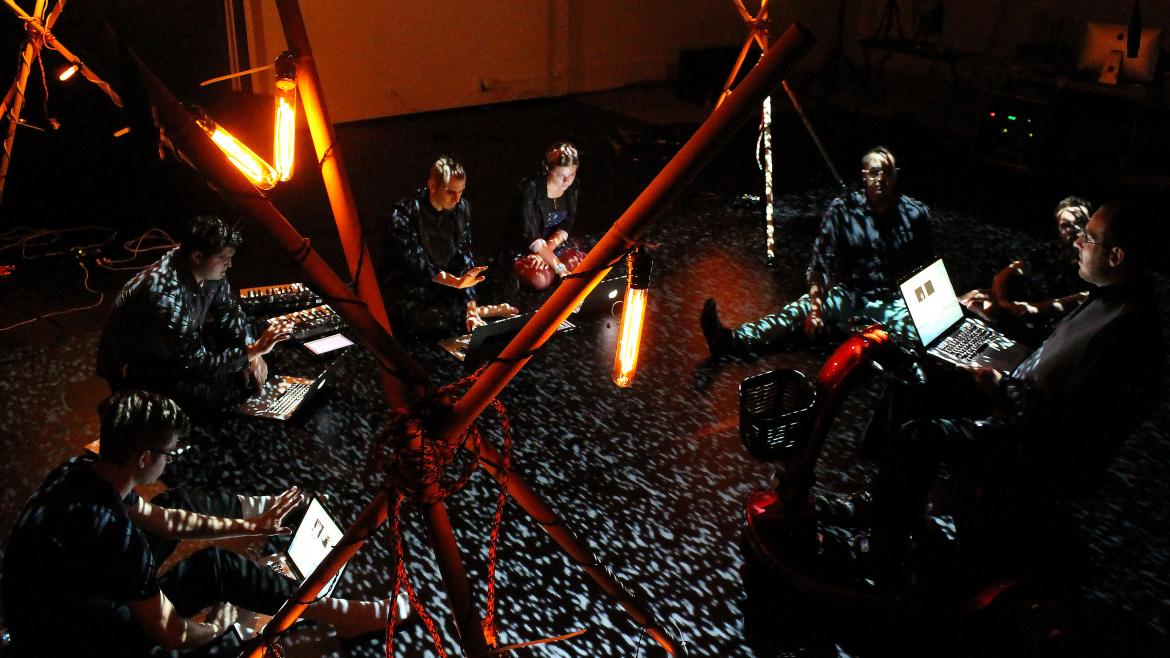Laptop computers have become such an essential part of our lives that it’s almost become odd to consider doing things like paying bills or buying a book without one.
But conducting an orchestra?
That’s the premise behind LORKAS, a student-run experimental “laptop orchestra” at Arizona State University that’s bridging the gap between the worlds of computer programming and performance art.
“We come from a wide swath of people. While I wouldn’t use the word ‘misfit-y,’ I definitely can say we’re a weird bunch,” said Althea Pergakis, a digital culture major in the School of Arts, Media and EngineeringThe School of Arts, Media and Engineering is a collaborative initiative between the Herberger Institute for Design and the Arts and the Ira A. Fulton Schools of Engineering., who is also the co-director of LORKAS.
The ensemble, which is comprised of 10 core members, includes instrumentalists, programmers, composers, audio engineers, designers, singers and fabrication specialists. As a whole, it’s encouraging creative expression with technology and the arts.
“Half the people are into digital media while the other half are coming from the School of MusicThe School of Music is part of the Herberger Institute for Design and the Arts.. We are all looking for something new, weird and different,” Pergakis said. “Essentially, LORKAS is a sandbox that allows us to go to a special place and explore.”

LORKAS, ASU's student-run laptop orchestra, performs by coding music both before and during performances.
Photo by Garrett Mitchell (Top photo by Matthew Briggs)
The group will participate in the annual School of Music Prisms Contemporary Music Festival, which runs Nov. 4-7 on ASU’s Tempe campus. This year the festival will honor renowned French composer Pierre Boulez, celebrating his 90th birthday.
As part of the festival, LORKAS is hosting a Nov. 4 workshop featuring Diemo Schwarz, an artist and executive with Paris-based Ircam, considered one of the more cutting-edge, non-profit research centers in the field of music technology and the media arts.
Founded in 2010, LORKAS was inspired by other laptop orchestras that began popping up after Stanford University debuted the concept a decade ago. The orchestra uses specialty-software equipped laptops to create original compositions in an improvisational manner, enhanced by gestural controls, eyesight cameras and wireless DMX lighting to create a one-of-a-kind sonic and aesthetic experience.
“We are generating live sounds and a lot of the music is improvisational,” Pergakis said. “We really do try to add a little zing to our set by immersing people in the sound.”
Each “instrument” consists of a laptop, an individual speaker, and a variety of control devices such as keyboards, graphic tablets and sensors which are run by ChucK, a music programming language that allows participants to code both in preparation for and during an actual performance.
“I find the interactivity between human beings and technology to be fascinating,” said co-director Justin Leo Kennedy, who is working on his Doctor of Musical Arts in composition in the School of Music. “There’s a stigma that the millennials have ruined a generation of music because of technology. And if I hear that one more time, I’ll probably throw up.”
LORKAS is also adding a little zing to its professional resume. December will see the release of their first album, “Nodes,” which includes 60 minutes of original compositions.
“People should come to LORKAS and see that both technology and music are what we decide to make of it,” Kennedy said.
More Science and technology

Apollo lunar samples enable ASU researcher to pinpoint moon’s crystallization timeline
A team of researchers, including Arizona State University geochemist Melanie Barboni, in collaboration with scientists from The University of Chicago, have made a new discovery about the history of…

NASA launches space telescope to chart the sky and millions of galaxies
California’s Vandenberg Space Force Base was the site for Tuesday’s 8:10 p.m. launch of the NASA SPHEREx mission aboard a SpaceX Falcon 9 rocket.The SPHEREx (Spectro-Photometer for the History of the…

ASU-led Southwest Sustainability Innovation Engine funds 8 promising tech startups
In the startup world, tech companies often fall victim to what’s known as the “valley of death” — the gap between technological proof of concept and actual viable product.Aiming to bridge this…


